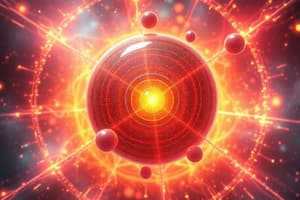Podcast
Questions and Answers
What is the primary role of protons in an atom, and how do they determine the element of an atom?
What is the primary role of protons in an atom, and how do they determine the element of an atom?
The primary role of protons is to determine the element of an atom, and they do this by their number in the atom, which is known as the atomic number.
What is the difference between the mass of a proton and the mass of an electron?
What is the difference between the mass of a proton and the mass of an electron?
The mass of a proton is approximately 1 atomic mass unit (amu), while the mass of an electron is approximately 1/1836 amu.
What happens when a neutron undergoes beta decay?
What happens when a neutron undergoes beta decay?
When a neutron undergoes beta decay, it decays into a proton, electron, and neutrino.
What determines the chemical properties of an element, and how is this related to the number of electrons in an atom?
What determines the chemical properties of an element, and how is this related to the number of electrons in an atom?
How do electrons move between energy levels in an atom, and what is involved in this process?
How do electrons move between energy levels in an atom, and what is involved in this process?
What are subatomic particles, and what is their role in forming atoms?
What are subatomic particles, and what is their role in forming atoms?
What is the difference between fermions and bosons?
What is the difference between fermions and bosons?
What are the three main properties of subatomic particles?
What are the three main properties of subatomic particles?
What is the role of gluons in the strong nuclear force?
What is the role of gluons in the strong nuclear force?
What is the difference between the weak nuclear force and the electromagnetic force?
What is the difference between the weak nuclear force and the electromagnetic force?
What is the role of the Higgs boson in giving mass to particles?
What is the role of the Higgs boson in giving mass to particles?
Flashcards are hidden until you start studying
Study Notes
Subatomic Particles
Protons
- Positive charge
- Found in the nucleus of an atom
- Mass: approximately 1 atomic mass unit (amu)
- Charge: +1 elementary charge
- Stable particles, do not decay into other particles
- Number of protons in an atom determines the element of an atom (atomic number)
Neutrons
- No charge (neutral)
- Found in the nucleus of an atom
- Mass: approximately 1 amu
- No charge, but contributes to the overall mass of the atom
- Can decay into a proton, electron, and neutrino (beta decay)
- Number of neutrons in an atom determines the isotope of an element
Electrons
- Negative charge
- Found in the electron cloud surrounding the nucleus of an atom
- Mass: approximately 1/1836 amu (very light)
- Charge: -1 elementary charge
- Can move from one energy level to another by absorbing or emitting energy (photon)
- Number of electrons in an atom is equal to the number of protons (in a neutral atom) and determines the chemical properties of an element
Subatomic Particles
Protons
- Carry a positive charge
- Located in the nucleus of an atom
- Approximate mass: 1 atomic mass unit (amu)
- Charge: +1 elementary charge
- Stable particles that do not decay into other particles
- The number of protons determines the element of an atom (atomic number)
Neutrons
- Have no charge (neutral)
- Located in the nucleus of an atom
- Approximate mass: 1 amu
- Contribute to the overall mass of the atom
- Can undergo beta decay, resulting in a proton, electron, and neutrino
- The number of neutrons determines the isotope of an element
Electrons
- Carry a negative charge
- Found in the electron cloud surrounding the nucleus of an atom
- Approximate mass: 1/1836 amu (very light)
- Charge: -1 elementary charge
- Can change energy levels by absorbing or emitting energy (photon)
- The number of electrons in an atom equals the number of protons (in a neutral atom) and determines the chemical properties of an element
Subatomic Particles
Definition
- Subatomic particles are the building blocks of matter that make up atoms, the smallest units of a chemical element.
Types of Subatomic Particles
Fermions
- Quarks are the building blocks of protons and neutrons.
- There are six types of quarks: up, down, charm, strange, top, and bottom.
- Leptons are particles that do not participate in the strong nuclear force.
- There are six types of leptons: electron, muon, tau, electron neutrino, muon neutrino, and tau neutrino.
Bosons
- Photons are the carriers of electromagnetic force.
- Gluons are the mediators of strong nuclear force.
- W and Z bosons are the mediators of weak nuclear force.
- The Higgs boson is responsible for giving mass to particles.
Properties of Subatomic Particles
- Particles can have positive, negative, or no charge.
- Particles can have varying masses, with some being massless, such as photons.
- Particles can have integer or half-integer spin, which determines their behavior.
Interactions of Subatomic Particles
- The strong nuclear force holds quarks together inside protons and neutrons, and holds these particles together inside the nucleus.
- The weak nuclear force is responsible for certain types of radioactive decay.
- The electromagnetic force acts between charged particles, such as protons and electrons.
- Gravity is the weakest of the four fundamental forces, but dominant at large scales.
Studying That Suits You
Use AI to generate personalized quizzes and flashcards to suit your learning preferences.




